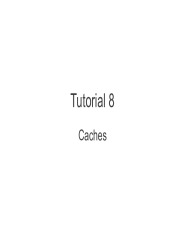Cache Memory course
A computer has different types of memory that are distinguished by their access speeds. The faster the memory is, the more expensive it is and the less the amount available on the computer. The internal or floating internal registers of the microprocessor constitute the memory to which it accesses the fastest but they are in very limited number. Then there is the RAM, the hard drives and then the tapes, which are very slow but which allow to store very large amounts of data.
The caches are intermediate between the internal registers of the microprocessor and the RAM. They are made of fast memory but they are reduced in size compared to the main memory.
When it comes to speed of access to memory, we must distinguish between latency and throughput. Latency is the time that elapses between the request for data and the arrival of the first data. The flow rate then measures the flow of data transmitted during the steady state, that is to say after the latency has elapsed. For a hard disk, the latency is relatively long because the read head must be positioned mechanically and then wait until the right sector is under the head.
For some time now, there has been a gap between the speed of microprocessors and the speed of dynamic memories that are used as main memory of computers. SDRAMs increase throughput but minimize latency. To prevent the microprocessor from losing time to wait for the data in the memory, memory caches formed from faster static memories are interposed between the microprocessor and the main memory. The purpose is similar to that of disk caches to speed up access to hard disks.
Table of contents
- Memory Hierarchy
- Principles of locality
- Cache memory
- Direct access
- Partially associative
- Completely associative
- Considerations with respect to memory entries
- Instruction cache and unified cache
- Common definitions
- Cache Organization
- Side note: byte address, block address
- Design code suitable for cache
- Rearrange the loops to improve the spatial locality
- Use blocking to improve temporal locality
| Size : | 125.88 Kb |
| File type : | |
| Downloads: | 640 |
| Created: | 2016-12-31 |
Warning: Trying to access array offset on false in /home/tutovnfz/public_html/article.php on line 233
Others Memory Tutorials
Guide RAM and ROM Based Digital Design
ROM, EPROM, and EEPROM pdf tutorial
Others related eBooks about Cache Memory course
Introduction to ARM Memory and Assembly LanguageDownload free pdf tutorial about ARM Memory and Assembly Language,training document for beginners....
How To Build Your Own PCWe'll walk you through everything you need to know to build your own PC. This is a free Building PC PDF tutorial in 19 chapters and 26 pages....
Computer Lessons for beginners in PDFThis article is a comprehensive guide to computer lessons for beginners, covering the essential skills and knowledge necessary to operate a computer effectively....
IEA International Computer and Information Literacy Study 2018 Assessment FrameworkDownload free course IEA International Computer and Information Literacy Study 2018 Assessment Framework, pdf file on 77 pages by Julian Fraillon, John Ainley, Wolfram Schulz, Daniel Duckworth, Tim Friedman....
Computer Vision MetricsDownload free course Computer Vision Metrics, pdf file on 498 pages by Scott Krig....
Intelligent Human Computer InteractionDownload free course Intelligent Human Computer Interaction, pdf file on 227 pages by Patrick Horain, Catherine Achard, Malik Mallem....
How to Think Like a Computer ScientistDownload free course How to Think Like a Computer Scientist, pdf file on 280 pages by Allen Downey, Jeffrey Elkner, Chris Meyers....
Analysis for Computer ScientistsDownload free course Analysis for Computer Scientists, pdf file on 372 pages by by Michael Oberguggenberger, Alexander Ostermann....
Introduction to Computing Explorations in Language, Logic, and MachinesThis book introduces the most important ideas in computing using the Scheme and Python programming languages, free download ebook in creative commons license....
Computer basics PDF tutorialThis course describes the basics components of computer (software, hardware, input and output devices), free training document in pdf for download....
